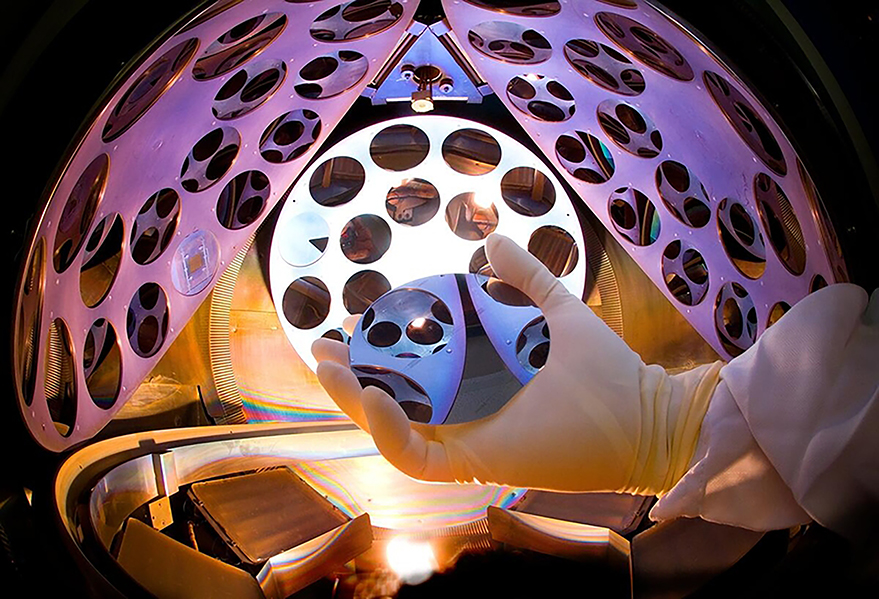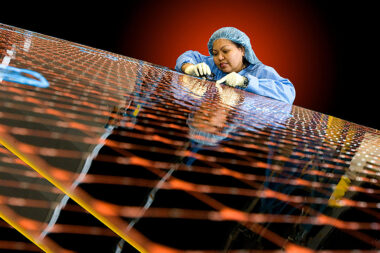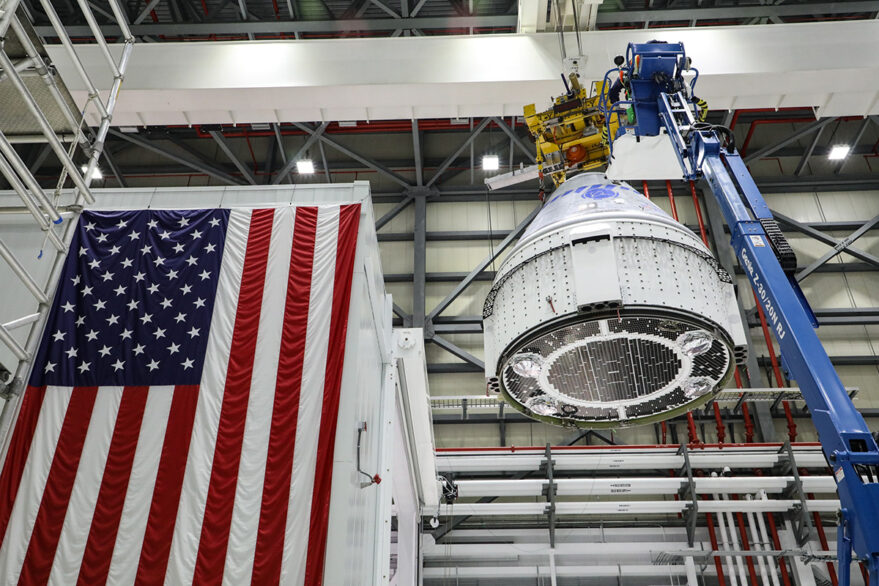
For six decades, Spectrolab has been building the long-lasting solar cells that power satellites and spaceships. Next up: compact, ultra-powerful new solar arrays for the ISS.
Spectrolab’s office sits in a nondescript office park in California’s San Fernando Valley, just minutes west of Angeles National Forest. Positioned prominently in the main conference room hangs an iconic photo from the Apollo 11 moon landing.
The image is one we all know: an astronaut in his cumbersome white suit of armor, standing on the grey surface of the moon. The Lunar Module Eagle and planted American flag sit in the background, against a black sky. But familiar as it is, it’s a special one for Spectrolab employees. Shot by commander Neil Armstrong just hours after humans first landed on the moon in 1969, the picture shows pilot Buzz Aldrin in front of a seismic experiment the astronauts had set up to measure “moonquakes” and provide information about the internal structure of the moon. The seismometer’s antenna is pointed at Earth, and two panels of solar cells—which converted the sun’s energy into electricity to power the experiment—are deployed on each side. Since the experiment relied on solar power, it only gained power during the lunar days, of course. During the 340-hour frigid lunar nights, the instrument was kept warm enough to function with a radioisotope heater, the first major use of nuclear energy in a NASA human spaceflight mission.
“This is such a point of pride for us,” said Tony Mueller, president of Spectrolab. “We manufactured those solar cells that landed on the moon.”
Solar cells built by Spectrolab, a wholly-owned subsidiary of The Boeing Company, have helped power the United States in space for the past six decades, including on NASA’s Mars Rover Opportunity, which was designed with a 90-day mission lifetime and lasted 15 years in operation on the surface of Mars starting in 2004; and solar-powered Juno, which arrived at Jupiter in 2016 and broke a record for a solar-powered vehicle, operating 493 million miles from the sun. To date, the company has built and delivered more than 6.5 million multi-junction gallium arsenide solar cells for more than 1,000 spacecraft over the last 65 years
“You look at those milestones, and it’s such a privilege to be a vital part of the space program for so many years,” Mueller said. “It’s clear that we’re doing something positive for humankind.”
Perhaps the most compelling success for Spectrolab these days comes from the International Space Station—whose main flagship solar arrays are 100 percent powered by Spectrolab’s space-grade solar cells and is equipped with the largest power-generating panels ever deployed in space. Spectrolab built the first 200,000 original solar cells that have kept the football field-sized ISS powered since 2000. The company also manufactured and deployed the cells used for Boeing’s CST-100 Starliner spacecraft, which will be used to transport crew to the ISS, and the prototype Roll-Out Solar Array, or iROSA, tested aboard the ISS in 2017. Last summer, two additional—and twice as efficient—solar arrays featuring Spectrolab cells were launched to augment the ISS power system. Four more arrays are scheduled to launch in the next two years.
“We’re delighted that the cells designed in the 1990s, continue to operate and provide robust power to ISS,” Mueller said. “With the new arrays, we’ve got several generations of technology on the ISS. The takeaway is that the space station lifespan is lengthened for humankind’s ability to conduct experiments, because the system powering it every day and night is working.”
From Legos to launches

Growing up in California, Mueller was fascinated with flying objects—first airplanes and then spaceships. His favorite Lego set included a rocket launchpad and vehicles on a moonscape. In the 1980s, he watched the first Space Shuttle launches and couldn’t get enough “Star Wars.”
“I remember reading National Geographic and seeing vivid pictures of Jupiter and Saturn from the Voyager mission in the late 1970s and early 1980s,” Mueller said. “Amazing to think only 15 years later I would be working in this industry.” Today, Mueller leads a team of 240 at Spectrolab, the world’s largest manufacturer of spacecraft solar cells, integrated panels and wings.
The company, founded in 1956 by entrepreneur and philanthropist Alfred Mann, was sold to Textron in 1960, Hughes Aircraft Company in 1975 and Boeing in 2000. In 1958, Pioneer 1 carried the company’s first body-mounted solar panels into space; the following year, Spectrolab supplied the first-ever space solar panel array to NASA’s Explorer 6 satellite, which provided the first photograph of Earth from space.
Thus far, Spectrolab has produced more than 5 megawatts of space grade solar cells. As a merchant supplier, Spectrolab sells product not only to its parent company but also to seven of the 10 largest aerospace companies in the world. These customers serve mission areas in the commercial satellite industry, the Department of Defense and NASA. Its cells and panels have historically provided the majority of the power of all U.S. satellites in Earth’s orbit (Low Earth Orbit, Medium Earth Orbit and Geosynchronous Equatorial Orbit), and it’s one of only three companies in the world—and the oldest—that manufacture space-grade solar cells. (Spectrolab’s solar work led to the development of its line of high-intensity searchlights for the airborne law enforcement community worldwide, which accounts for about 10 percent of the company’s business.)
Mueller recently began his 29th year within the company. People often ask him what’s special about Spectrolab’s space solar cell. For starters, it’s made from high-grade materials that are more technologically advanced than solar cells used on Earth. Then there’s the demanding environment of space, including temperatures that land-based solar arrays never encounter.
“Our solar cell needs to be about twice as efficient as what we see on the ground,” Mueller said. “It needs to survive for 15 years or more and live through temperature swings that are sometimes greater than 200 degrees Celsius from low side to high side.”
Over the years, innovations and advances in solar cell technology have led to an even more effective solar cell (Spectrolab currently has more than 150 active U.S. patents). The first cells were approximately 10 percent efficient. Spectrolab’s XTJ Prime, what is now flying on the ISS, tripled that at 30.7 percent efficiency, while the latest product, XTE, is 32 percent efficient—designed to support the missions of tomorrow. Today Spectrolab has the ability to produce greater than 500,000 watts per year with state-of-the-art multijunction solar cells and panels, which equates to more than 30 high-power satellites.
The efficiency of the solar cells depends heavily on the environment. Each cell—which is thicker and more durable than terrestrial solar cells—is tested in a strictly controlled environment in Spectrolab’s 180,000-square-foot facility, with qualification testing done to even more extreme settings than the radiation and thermal cycling it will encounter in space. Each cell is treated with a special coating that captures the sun’s energy and reflects off what isn’t needed.
“Every mission is unique,” said Mueller. “So we take our standard design and tweak the solar cells to make them suitable for their intended environment. If it were Low Earth Orbit with lots of thermal cycles, for example, we might adjust our processes or use different adhesives to accommodate high thermal stress. Every cell is tuned to give our customers optimum performance in space.”
Powering the ISS for many years and experiments to come
Spectrolab’s new ISS arrays are half the size of the space station’s original arrays, but they are woven with stronger, more efficient solar cells that make them doubly powerful. Measuring 63 by 20 feet, the arrays will produce more than 120 kilowatts of electricity, enough to power more than 40 average U.S. homes; combined with the eight originals, the six new arrays will produce 215 kilowatts. That’s a 20- to 30-percent boost in power for the station’s systems and equipment, a larger permanent crew of seven, new research capabilities and several new commercial modules slated for later this decade.
“These arrays are critical to the overall power system upgrade to the ISS that NASA and Boeing have undertaken. It was the efficiency of the new generation of solar cells that allowed us to make arrays small enough to fit in ISS cargo ships but still big enough to do the job of increasing power to the station,” said John Mulholland, vice president and program manager for Boeing’s ISS program. “That increased capability is setting the stage for ISS to host new commercial modules in the near-future and operate for years to come as a research center and business incubator.”
The six new ISS arrays are comprised of more than 1,150 solar power modules and more than 55,000 solar cells. The installation of the first two, in 2021, marked the biggest structural change to the space station in a decade. Boeing developed the arrays to fold small enough to be packed on a space-rated pallet that fits inside the trunk of the cargo spacecraft that ferried the arrays to the ISS. The arrays positioned on a structure from Redwire allowed them to be rolled tight for launch and to unroll on their own energy instead of requiring a motor. Once on orbit, the folded arrays were removed by the ISS’ robotic arm and were then positioned so the spacewalkers could take them out to the far end of the ISS truss for installation.
Mueller expects an increase in demand for modular solar cells and flexible arrays, like those Spectrolab built for the ISS and NASA through the Redwire and Boeing partnership. Peering in his crystal ball, he also sees a future that might explode in terms of power demand in Earth’s orbit. “We’re at a critical pivot point,” he said. “We see the need for space power growing, so we’re looking at scaling up to meet that demand.” He said to do that, the technical manufacturing process will become more automated. “Today it’s a mix—some processes are automated, and some require manual craftsmanship,” he said. “As we scale up, we’ll definitely need more automation.”
No matter where the industry heads, Mueller said, he’s certain that Spectrolab is changing lives—for his colleagues, but also on a much grander scale. “If you take a step back, looking at what’s going on in the world today and what we’ve been involved with historically, we’re part of a mission for good,” he said. “Our product powers satellites and space exploration vehicle, and at the end of the day, these missions connect, protect and transform.”
